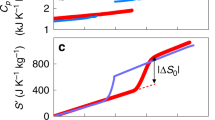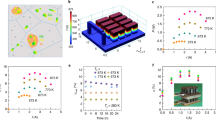Abstract
Enzymatic reactions are orders of magnitude faster in liquid paraffins than in solid ones. For example, horseradish peroxidase oxidizes p–anisidine in liquid hexadecane or pentadecane several million fold faster than in the solid hydrocarbons. This effect can be used to design a simple enzymatic sensor for temperature abuse of foods, pharmaceuticals and other thermolabile products.
This is a preview of subscription content, access via your institution
Access options
Subscribe to this journal
Receive 12 print issues and online access
$209.00 per year
only $17.42 per issue
Buy this article
- Purchase on Springer Link
- Instant access to full article PDF
Prices may be subject to local taxes which are calculated during checkout
Similar content being viewed by others
References
Van Arsdel, W.B., Copley, M.J., and Olson, R.L. (eds.) 1969. Quality and Stability of Frozen Foods. Wiley Interscience, New York.
Fennema, O.R., Powrie, W.D., and Marth, E.H. 1973. Low Temperature Preservation of Foods and Living Matter. Marcel Dekker, New York.
Jul, M. 1984. The Quality of Frozen Foods, p. 245–252. Academic Press, New York.
Olley, J. 1976. Temperature indicators, temperature integraters, temperature function integrators and the food spoilage chain. Bull. Int. Inst. Refrig. (Annexe 1976-1), 125–132.
Byrne, C.H. 1976. Temperature indicators—the state of the art. Food Technol. 30(6):66–68.
Klibanov, A.M. 1986. Enzymes work in organic solvents. ChemTech 16(6):354–359.
Cesti, P., Zaks, A., and Klibanov, A.M. 1985. Preparative regioselective acylation of glycols by enzymatic transesterification in organic solvents. Appl. Biochem. Biotechnol. 11:401–407.
Kazandjian, R.Z. and Klibanov, A.M. 1985. Regioselective oxidation of phenols catalyzed by polyphenol oxidase in chloroform. J. Amer. Chem. Soc. 107:5448–5450.
Kirchner, G., Scollar, M.P., and Klibanov, A.M. 1985. Resolution of racemic mixtures via lipase catalysis in organic solvents. J. Amer. Chem. Soc. 107:7072–7076.
Kazandjian, R.Z., Dordick, J.S., and Klibanov, A.M. 1986. Enzymatic analyses in organic solvents. Biotechnol. Bioeng. 28:417–421.
Dixon, M. and Webb, E.C. 1979. Enzymes, 3rd edition, p. 92–93. Academic Press, New York.
Weast, R.C., Ed. 1979. CRC Handbook of Chemistry and Physics, 60th edition. Section C. CRC Press. Boca Raton, FL.
Hammond, D.A., Karel, M., Klibanov, A.M., and Krukonis, V.J. 1985. Enzymatic reactions in supercritical gases. Appl. Biochem. Biotechnol. 11:393–400.
Schumb, W.C., Satterfield, C.N., and Wentworth, R.L. 1955. Hydrogen Peroxide, p. 553–557. Reinhold Publishing Co., New York.
Author information
Authors and Affiliations
Rights and permissions
About this article
Cite this article
Boeriu, C., Dordick, J. & Klibanov, A. Enzymatic Reactions in Liquid and Solid Paraffins: Application for Enzyme–Based Temperature Abuse Sensors. Nat Biotechnol 4, 997–999 (1986). https://doi.org/10.1038/nbt1186-997
Received:
Accepted:
Issue Date:
DOI: https://doi.org/10.1038/nbt1186-997
This article is cited by
-
Biocatalysis and biorecognition in nonaqueous media. Some perspectives in analytical biochemistry
Mikrochimica Acta (1995)
-
Biological production of acetaldehyde from ethanol using non-growingPichia pastoris whole cells
Applied Biochemistry and Biotechnology (1991)
-
Patents and literature biocatalysis in nonaqueous media
Applied Biochemistry and Biotechnology (1988)



